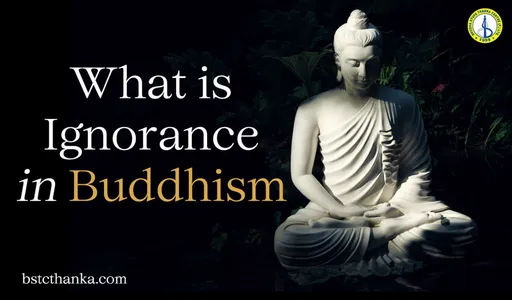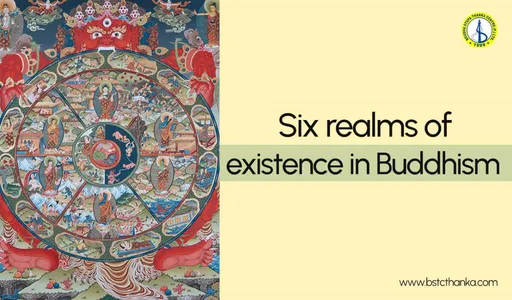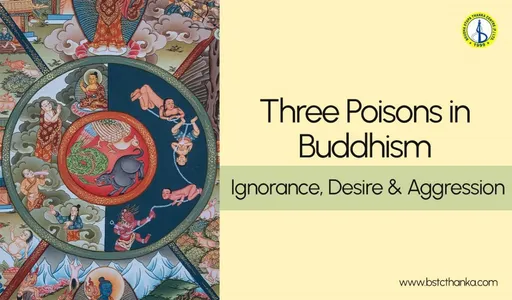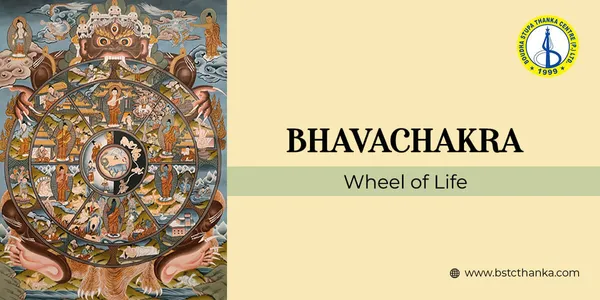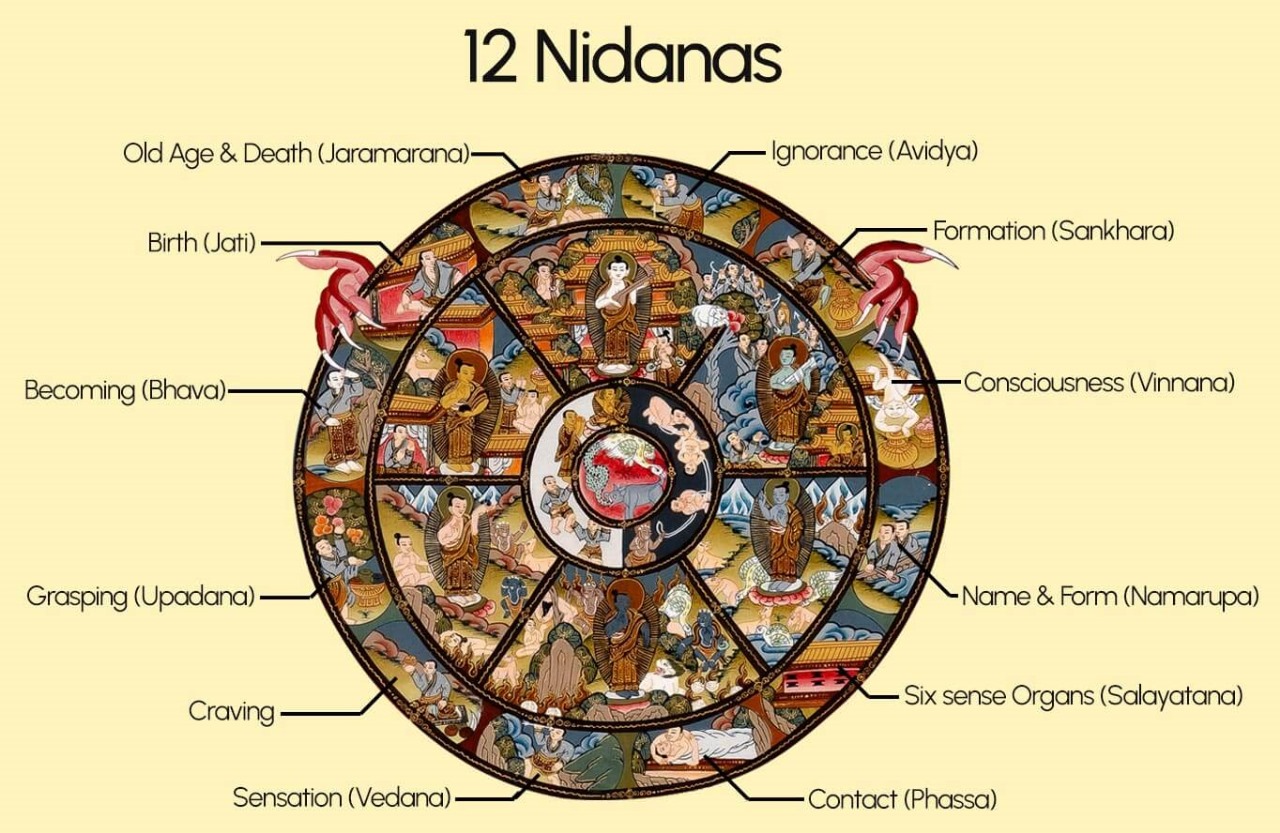
12 Links of Dependent Origination: 12 Nidanas in Buddhism
The 12 Links of Dependent Origination, also known as the 12 Nidanas, are fundamental concepts in Buddhism that explain the cycle of birth, death, and rebirth. These links describe how one event leads to another, creating a chain of cause and effect that keeps beings trapped in samsara, the cycle of suffering. Starting with ignorance and ending with old age and death, each link represents a step in this continuous process. Understanding these links helps us see how our actions and thoughts contribute to our ongoing experiences of suffering and rebirth.
The 12 Links of Dependent Origination are often depicted in the Wheel of Life, a symbolic representation of samsara. The Wheel of Life includes these links, demonstrating how each link leads to the next, perpetuating the cycle of suffering. In the diagram, the outer rim shows the 12 links of dependent origination, while the inner circle features the three poisons, illustrating the interconnection between ignorance, craving, and the cycle of suffering. Understanding the 12 nidanas offers a roadmap to escape this cycle and achieve enlightenment.
What are the Twelve Links of Dependent Origination?
The twelve nidanas describe the process by which our suffering and dissatisfaction arise. The 12 links of dependent origination are ignorance, formation, consciousness, name and form, six sense organs, contact, sensation, craving, grasping, becoming, birth, old age and death. Let’s explain each of these nidanas in detail:
1. Ignorance (Avidya)
Ignorance (Avidya) in Buddhism is considered the first link in the chain of dependent origination. This means that ignorance is the starting point for the cycle of suffering and rebirth. Ignorance, in this context, refers to a lack of understanding about the true nature of reality. Specifically, it means not knowing the Four Noble Truths, which explain the nature of suffering, its cause, its end, and the path to its end. Because of this ignorance, people develop misconceptions about themselves and the world, leading to actions that create further suffering.
When people are ignorant, they fail to see things as they truly are. This ignorance leads to the formation of desires and attachments, which in turn lead to actions that bind them to the cycle of birth, death, and rebirth. By understanding and overcoming ignorance, one can break this cycle and achieve enlightenment. In essence, overcoming ignorance is the first step towards liberation from suffering.
2. Formation (Sankhara)
The formation, or Sankhara, is the second link in the 12 ideas shown in the Wheel of Life thangka. It refers to the mental formations or volitional actions that shape our experiences and future lives. These formations are the result of our thoughts, words, and deeds, which create karma. Karma, in turn, influences our future rebirths and the conditions of our existence. Essentially, Sankhara represents the intentional actions that arise from our ignorance and desires, leading to the continuation of the cycle of suffering and rebirth.
When we act based on ignorance, our actions create mental imprints or habits that shape our consciousness. These mental formations condition our perceptions and reactions, further entangling us in the cycle of samsara, the endless cycle of birth, death, and rebirth. By understanding and transforming these formations, we can begin to break free from this cycle. In simple terms, Sankhara highlights the importance of our actions and their impact on our spiritual journey.
3. Consciousness (Vinnana)
Consciousness (Vinnana) is the third link in the twelve links of dependent origination, a core teaching in Buddhism. It refers to the basic awareness or cognition that arises when our senses come into contact with objects or when our mind encounters thoughts and feelings. This consciousness is not a permanent self or soul but rather a continually changing process of knowing and experiencing.
In simple terms, consciousness is like a stream of mental activity that allows us to perceive and understand the world around us. In the context of 12 Nidanas, Vinnana is not independent but arises due to past actions and mental formations and, in turn, gives rise to further links in the chain of existence. Overcoming attachment to consciousness is crucial in the Buddhist path to liberation. By recognizing that consciousness is impermanent and not a fixed self, we can begin to let go of our clinging to experiences and perceptions. This understanding helps break the cycle of suffering by reducing our tendency to identify with fleeting mental states, ultimately leading to freedom from the cycle of rebirth.
4. Name and Form (Namarupa)
Name and Form (Namarupa) is the fourth link in the twelve nidanas, a fundamental Buddhist teaching. It represents the mental and physical aspects of our existence. "Name" (Nama) refers to the mental components, including feelings, perceptions, intentions, and consciousness. "Form" (Rupa) represents the physical aspects, including our body and the material world we interact with.
Name and Form is how we experience ourselves and the world around us. It's the combination of our thoughts, emotions, and physical sensations that make up our lived experience. This link arises dependent on consciousness and, in turn, conditions the six sense bases. Understanding Name and Form as impermanent and interdependent helps us see through the illusion of a solid, unchanging self. By recognizing the fluid nature of our mental and physical experiences, we can reduce our attachment to them, decreasing suffering and moving us closer to liberation from the cycle of rebirth.
5. Six Sense Organs (Salayatana)
Six Sense Organs (Salayatana) is the fifth link in the twelve links of dependent arising. It refers to the six sense bases through which we perceive and interact with the world: eyes, ears, nose, tongue, body, and mind. In Buddhist philosophy, the mind is considered a sense organ because it processes thoughts and mental objects, just as the other organs process physical stimuli.
These six sense organs arise dependent on Name and Form and provide the foundation for Contact, the next link in the chain. They act as the gateways through which we experience the world, shaping our perceptions and reactions. Understanding the role of these sense organs is important because they often lead to attachment and aversion based on what we see, hear, smell, taste, feel, or think. By recognizing that these sense experiences are impermanent and not inherently satisfying, we can begin to loosen our grip on them. This awareness helps reduce craving and attachment, key factors in the cycle of suffering and moves us closer to liberation from the cycle of rebirth and attaining inner peace.
6. Contact (Phassa)
In Buddhist teachings, Contact (Phassa) is the sixth link in the chain of dependent origination. Contact refers to the moment when our sense organs come into contact with the objects of our senses. For example, when our eyes see something, our ears hear a sound, or our skin feels a touch, this creates a connection between our senses and the external world. Contact is the starting point for experiencing feelings and perceptions.
Contact follows the link of the Six Sense Organs, showing how our senses interact with what is around us. When contact occurs, it can lead to various feelings—pleasant, unpleasant, or neutral. These feelings can trigger cravings or aversions, which contribute to the cycle of suffering. Overcoming Contact is important because it allows us to see how our reactions to contact shape our experiences. By understanding this process, we can learn to respond with mindfulness and reduce our attachments, ultimately leading to greater peace and insight.
7. Sensation (Feeling or Vedana)
Sensation (Feeling) refers to the basic, instinctive feeling tone that arises when we encounter something through our senses. It can be pleasant, unpleasant, or neutral. For instance, when we taste delicious food, a pleasant sensation arises. If we hear a harsh noise, an unpleasant sensation occurs. Sometimes, we might see an ordinary object and feel a neutral sensation. These feelings happen automatically before we start thinking or reacting consciously.
Sensation is important to understand because it often drives our behavior. Pleasant sensations can lead to craving and attachment, while unpleasant ones can cause aversion. By observing our sensations mindfully, without immediately reacting to them, we can start to break the cycle of automatic responses that often lead to suffering. The awareness of feeling helps us respond to experiences more skillfully, reducing our tendency to grasp pleasurable sensations or push away unpleasant ones. In doing so, we move closer to freedom from the cycle of rebirth and the peace that comes with liberation.
8. Craving (Thirst)
Craving, often called "thirst," is a key link in the chain of dependent origination. It arises when we experience something through our senses, like seeing, hearing, or touching. This leads us to develop strong desires for things we want to have or avoid. Craving can be for physical pleasures, like tasty food or comfort, but it can also be for emotional states, such as love or security. When we let these desires take control, they can cause us to suffer and cling to things that ultimately do not last.
Tackling craving is important because it helps us break the cycle of suffering. When we understand that our desires are temporary and often unfulfilled, we can start to let them go. By learning to manage our cravings, we can find more peace and contentment in the present moment. This shift not only eases our own suffering but also allows us to live more freely and compassionately with others.
9. Grasping (Clinging or Upadana)
Grasping, also known as clinging or Upadana, is one of the twelve links in the chain of dependent origination in Buddhist philosophy. It refers to our tendency to hold onto things, ideas, or experiences that we find pleasant or desirable. This attachment can be to material possessions, relationships, beliefs, or even our own sense of self. Grasping arises from our craving for pleasant experiences and our aversion to unpleasant ones.
In the context of the twelve nidanas, grasping follows craving and leads to becoming. It represents a more intense form of desire, where we not only want something but actively try to possess or maintain it. This attachment to impermanent things causes suffering because it goes against the nature of reality, which is constantly changing. Overcoming or tackling this link is crucial because it helps break the cycle of suffering. By letting go of our attachments, we can experience greater freedom, peace, and a more accurate understanding of the world around us.
10. Becoming (Bhava)
Becoming, or bhava in Sanskrit, is the tenth link in the chain of dependent origination in Buddhist philosophy. It represents the process of coming into existence or taking on a particular form of life. This link follows grasping and precedes birth in the cycle. Becoming refers to the tendency of consciousness to manifest in a specific realm or state of existence based on past actions and current attachments. It's like preparing the ground for a new life or state of being.
In practical terms, becoming can be understood as the mental and emotional states that shape our future experiences. It's influenced by our habits, choices, and the things we cling to. These patterns create the conditions for our next rebirth or the next moment of our existence. Overcoming or tackling this link is important because it helps break the cycle of rebirth and suffering. By understanding and letting go of the processes that lead to becoming, we can reduce our attachment to particular forms of existence and move closer to liberation from the cycle of birth and death.
11. Birth (Jati)
Birth, or jati in Sanskrit, is the eleventh link in the 12 links of dependent origination. Birth refers to the beginning of a new life or the emergence of a new state of being. In the context of rebirth, it represents the moment when consciousness takes on a new form in one of the realms of existence. However, birth can also be understood metaphorically as new experiences or states of mind arising in our present life.
Birth follows becoming and precedes aging and death in the cycle. Birth brings with it the potential for both joy and suffering. It marks the start of a new set of experiences, relationships, and challenges. While birth itself is often seen as a positive event, in Buddhist thought, it's recognized as the beginning of a cycle that inevitably leads to suffering, aging, and death. Overcoming this link helps break the cycle of continuous rebirth and the suffering that comes with it. By understanding the causes that lead to birth and working to neutralize them, one can move closer to liberation from the cycle of samsara and the attainment of lasting peace.
12. Old Age and Death (Jaramarana)
Old age and death, or "jaramarana," is the final link in the chain of dependent origination. The last link represents the inevitable decline that comes with aging and the end of life itself. As we grow older, we face changes in our bodies and minds, and eventually, we must confront death. This reality can bring feelings of fear, sadness, and loss, reminding us that all things are temporary and that our time is limited.
The final link completes the cycle of dependent origination, following birth and leading back to ignorance, which starts the cycle anew. Old age and death are universal experiences that bring suffering, loss, and grief. They remind us of the impermanent nature of all things and the uncertainty of life. Overcoming this link, or more accurately, fully understanding and accepting it, is crucial because it can lead to profound peace and liberation. By deeply comprehending the nature of old age and death, one can reduce fear and attachment to life, leading to a more serene and mindful existence. This understanding can help break the cycle of rebirth, allowing one to transcend the continuous loop of suffering and attain the ultimate goal of liberation or nirvana.
What to Learn from 12 Nidanas?
The 12 Nidanas, or links of dependent origination, teach us important lessons about the nature of our experiences and suffering. They show how ignorance sets off a chain reaction, leading to the formation of our actions, consciousness, and identity. As we interact with the world through our senses, we develop sensations that spark cravings and grasping. These cravings and attachments shape our becoming, which influences our new births and experiences. Finally, this cycle of existence leads to aging and death, reminding us of the impermanence of everything. By understanding these links, we learn how our actions and desires continuously shape our lives and how breaking this cycle can lead to freedom from suffering.
FAQs
What are the 12 Links of Dependent Origination?
The 12 Links of Dependent Origination is a Buddhist teaching that explains how suffering arises. They show how one event leads to another, creating a cycle of birth, death, and rebirth. The links start with ignorance and end with old age and death.
Why are the 12 Nidanas important in Buddhism?
The 12 Nidanas are crucial in Buddhism because they help explain why we suffer. They show how our actions and thoughts lead to future experiences. Understanding these links can help us break the cycle of suffering and achieve enlightenment.
What is the first link in the chain?
The first link is Ignorance (Avidya). It refers to our lack of understanding of the true nature of reality. This misunderstanding leads to actions that keep the cycle going.
What's the significance of the last link, Old Age and Death?
Old Age and Death remind us of the impermanence of all things. This link completes the cycle, showing that everything that comes into being must eventually end.




